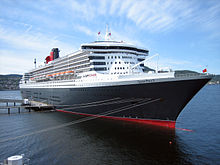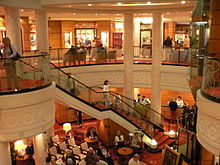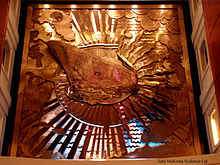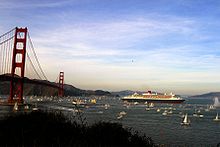
RMS Queen Mary 2
Background Information
SOS believes education gives a better chance in life to children in the developing world too. Sponsoring children helps children in the developing world to learn too.
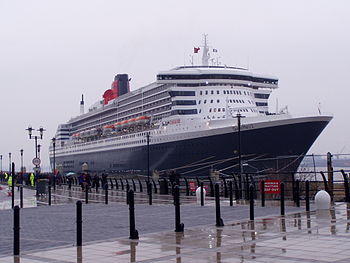 Queen Mary 2 at Pier Head, Liverpool, England during a 2009 visit Queen Mary 2 at Pier Head, Liverpool, England during a 2009 visit |
|
| Career | |
|---|---|
| Name: | RMS Queen Mary 2 |
| Namesake: | Queen Mary |
| Owner: | Carnival plc |
| Operator: | Cunard Line |
| Port of registry: | Hamilton, |
| Ordered: | 6 November 2000 |
| Builder: | STX Europe Chantiers de l'Atlantique, Saint-Nazaire, France |
| Cost: | UK £460 million (€700 million) (US$900 million) |
| Yard number: | G32 |
| Laid down: | 4 July 2002 |
| Launched: | 21 March 2003 |
| Christened: | 8 January 2004 by Queen Elizabeth II |
| Completed: | 23 December 2003 |
| Maiden voyage: | 12 January 2004 |
| Identification: | IMO number: 9241061 Callsign ZCEF6 MMSI number: 310627000 |
| Status: | In service in 2013 |
| Designer: | Stephen Payne |
| General characteristics | |
| Type: | Ocean liner |
| Tonnage: | 148,528 GT |
| Length: | 1,132 ft (345 m) |
| Beam: | 135 ft (41 m) waterline, 147.5 ft (45.0 m) extreme (bridge wings) |
| Height: | 236.2 ft (72.0 m) keel to (top of) funnel |
| Draught: | 33 ft (10.1 m) |
| Decks: |
13 passenger, 17 total decks |
| Installed power: | 4 x Wärtsilä 16V 46C-CR / 16,800 kW (22,848 mHP), 2 x GE LM2500+ / 25,060 kW (34,082 mHP) |
| Propulsion: | Four 21.5 MW Rolls-Royce/Alstom "Mermaid" electric propulsion pods: 2 fixed and 2 azimuthing |
| Speed: | 30 knots (56 km/h; 35 mph) |
| Capacity: | 2,620 passengers |
| Crew: | 1,253 officers and crew |
RMS Queen Mary 2 is a transatlantic ocean liner. She was the first major ocean liner built since Queen Elizabeth 2 in 1969, the vessel she succeeded as flagship of the Cunard Line. The new ship was named Queen Mary 2 by Queen Elizabeth II in 2004 after the first RMS Queen Mary, completed in 1936. Queen Mary was in turn named after Mary of Teck, consort of King George V. With the retirement of Queen Elizabeth 2 from active duty in 2008, Queen Mary 2 is the only transatlantic ocean liner in line service between Southampton and New York, which operates for part of each year. The ship is also used for cruising, including an annual world cruise.
Although not of British construction, the ship was designed by a team of British naval architects, led by Stephen Payne. At the time of her construction in 2003 by Chantiers de l'Atlantique, Queen Mary 2 was the longest, widest, and tallest passenger ship ever built, and with her gross tonnage of 148,528 also the largest. She no longer holds this distinction after the construction of Royal Caribbean International's 154,407 GT Freedom of the Seas in April 2006. Although later cruise ships are larger, Queen Mary 2 remains the largest ocean liner (as opposed to cruise ship) ever built.
The Queen Mary 2 was intended to routinely cross the Atlantic Ocean, and was therefore designed differently from many other passenger ships. The ship's final cost was approximately $300,000 US per berth, nearly double that of many contemporary cruise ships. Expenses were increased by the high quality of materials, and having been designed as an ocean liner, she required 40% more steel than a standard cruise ship. Queen Mary 2 has a maximum speed of just over 30 knots (56 km/h; 35 mph) and a cruising speed of 26 knots (48 km/h; 30 mph), much faster than a contemporary cruise ship. Instead of the diesel-electric configuration found on many ships, Queen Mary 2 uses integrated electric propulsion in order to achieve her top speed. This uses gas turbines to augment the power generated from the ship's diesels.
Queen Mary 2's facilities include fifteen restaurants and bars, five swimming pools, a casino, a ballroom, a theatre, and the first planetarium at sea. There are also kennels on board, as well as a nursery. Queen Mary 2 is one of the few ships afloat today to have remnants of a class system on board, as seen in her dining options.
On 19 October 2011, Queen Mary 2 had her registry changed to Hamilton, Bermuda, from her home port of Southampton, England to allow the ship to host on-board weddings. This ended 171 years of British registry for Cunard ships.
Characteristics
Queen Mary 2 is the flagship of the Cunard Line. The ship was constructed to eventually replace the ageing RMS Queen Elizabeth 2, the Cunard flagship from 1969 to 2004 and the last major ocean liner built before the construction of Queen Mary 2. Queen Mary 2 has the Royal Mail Ship (RMS) title conferred on her, as a gesture to Cunard's history, by Royal Mail when she entered service in 2004 on the Southampton to New York route.
Queen Mary 2 is not a steamship like many of her predecessors, but is powered primarily by four diesel engines, with two additional gas turbines used when extra power is required; this integrated electric propulsion configuration is used to produce the power to drive her four electric propulsion pods as well as powering the ship's hotel services.
Like her predecessor Queen Elizabeth 2 she is built for crossing the Atlantic Ocean, though she is regularly used for cruising; in the winter season she cruises from New York to the Caribbean on ten- or thirteen-day tours. Queen Mary 2's 30-knot (56 km/h; 35 mph) open ocean speed sets the ship apart from cruise ships, such as Oasis of the Seas, which has an average speed of 22.6 knots (41.9 km/h; 26.0 mph); QM2's normal service speed is 26 knots (48 km/h; 30 mph).
Design and construction
Cunard completed a design for a new class of 84,000 GT, 2,000 passenger liners on 8 June 1998, but revised them upon comparing those specifications with Carnival Cruise Lines' 100,000 GT Destiny class cruise ships and Royal Caribbean International's 137,200 GT Voyager class.
In December 1998, Cunard released details of Project Queen Mary, the project to develop a liner that would complement Queen Elizabeth 2. Harland and Wolff of Northern Ireland, Aker Kværner of Norway, Fincantieri of Italy, Meyer Werft of Germany, and Chantiers de l'Atlantique of France were invited to bid on the project. The contract was finally signed with Chantiers de l'Atlantique, a subsidiary of Alstom, on 6 November 2000. This was the same yard that built Cunard's former rivals, the SS Normandie and SS France of the Compagnie Générale Transatlantique.

Her keel was laid down in the Louis Joubert Lock on 4 July 2002, in Saint-Nazaire, France, with the hull number G32. The QM2 was the first ship to use the huge drydocks since the shipyard built large tankers in the 1970s, such as the MV Gastor. Approximately 3,000 craftsmen spent around eight million working hours on the ship, and around 20,000 people were directly or indirectly involved in her design, construction, and fitting out. In total, 300,000 pieces of steel were assembled into 94 "blocks" off the drydock, which were then stacked and welded together to complete the hull and superstructure.
Queen Mary 2 was floated on 21 March 2003. Her sea trials were conducted between 25 September-29 September and 7–11 November 2003, between Saint-Nazaire and the offshore islands of Ile d'Yeu and Belle-Ile. The final stages of construction were marred by a fatal accident on 15 November 2003, when a gangway collapsed under a group of shipyard workers and their relatives who had been invited to visit the vessel. In total, 32 people were injured and 16 were killed, after a 15-metre (49 ft) fall into the drydock.
Construction was completed on schedule. Cunard took delivery in Southampton, England on 26 December 2003. On 8 January 2004, the liner was named by her namesake's granddaughter, Queen Elizabeth II.
Exterior
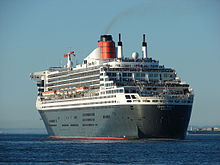
Queen Mary 2's principal naval architect was Carnival's in-house designer, Stephen Payne. Payne intended many aspects of the ship's design to resemble notable aspects of former ocean liners, such as Queen Elizabeth 2 and the ship's predecessor Queen Mary. These features include the three thick black lines that wrap around either edge of the ship's bridge screen, and at the stern end of the superstructure, which are to recall the appearance of the crossovers of the forward decks on the first Queen Mary.
Queen Mary 2 has 14,164-square-metre (3.500-acre) of exterior deck space, with wind screens to shield passengers as the ship travels at high speeds. Four of the ship's five swimming pools are outdoors. One of the pools on Deck 12 is covered with a retractable magrodome. The indoor pool is on Deck 7, in the Canyon Ranch Spa Club.
In common with liners such as RMS Queen Mary, there is a continuous wrap around promenade deck on Deck 7. The promenade passes behind the bridge screen and allows passengers to completely circumnavigate the deck while protected from the strong winds generated by the ship at speed. One circuit of the promenade is a distance of 620 m (2,030 ft). The flanking promenades are created by the need to step the superstructure in, to allow for space for lifeboats. By SOLAS standards the lifeboats should have been lower on the ship's hull (15 m (49 ft) above the waterline), but for the sake of Queen Mary 2's appearance as well as to avoid the danger of large North Atlantic waves damaging the boats in a storm, Payne convinced SOLAS officials to exempt the Queen Mary 2 from this requirement, and the boats are 25 m (82 ft) above the waterline.
Payne's initial intent was to make the ship's stern profile with a spoon shape, similar to that on most previous ocean liners, but the mounting of the propeller pods required a flat transom. The compromise was a constanzi stern – a combination of the two. The final design was agreed upon, as a Constanzi stern provides the transom required for azimuthal pod propulsors, and provides better seaholding characteristics in a following swell than a standard transom stern. In common with many modern ships, both passenger and cargo, Queen Mary 2 has a bulbous bow to reduce drag and thereby increase speed, range, and fuel efficiency.
While of a similar design to that of Queen Elizabeth 2, Queen Mary 2's funnel was designed with a slightly different shape. The difference was required because, due to the height of the vessel, a taller funnel would have made it impossible for the ship to pass under the Verrazano-Narrows Bridge in New York City at high tide. The final design now permits a minimum of 13 feet (4.0 m) of clearance under the bridge at high tide.
As Queen Mary 2 is too large to dock in many ports, passengers are ferried to and from the ship in tenders, which can be used as lifeboats in an emergency. While at sea, these are stored in davits alongside the lifeboats. To transport passengers to shore, the tenders pull up to one of four loading stations, each of which has a large hull door that hydraulically opens outwards to form a boarding platform, complete with railings and decking.
Queen Mary 2 is a post-panamax ship. As a result, the Queen Mary 2 must circumnavigate South America in order to cross between the Atlantic and Pacific. The decision not to constrain her size in order to transit the Panama Canal was taken as the Queen Elizabeth 2 only transited once a year, during the world cruise. Cunard decided to pass up the convenience of the occasional passage in favour of a larger passenger capacity.
Interior
As is the case with many modern passenger ships, many of the major public rooms on board Queen Mary 2 are on the lowest public decks of the ship, with the passenger cabins stacked above. This is the opposite of the traditional practice on ocean liners, but the design allowed for larger rooms to be contained within the stronger hull, as well as for more passenger cabins to have private balconies higher up on the ship, where they are less affected by large waves. Payne attempted to create a central axis to the two main public room decks (similar in fashion to the Normandie), but a full vista is broken by various public rooms that span the full beam of the ship. The dining rooms were placed further aft, though not directly at the stern, where the fore and aft pitching of the ship is most noticeable, and where vibration from the propellers at full speed might cause discomfort to dining passengers.
Deck 2, the lowest passenger deck, contains the Illuminations theatre, cinema and planetarium (the first at sea); Royal Court Theatre; Grand Lobby; "Empire Casino"; "Golden Lion Pub"; and the lower level of the "Britannia Restaurant". Deck 3 holds the upper levels of "Illuminations", the "Royal Court theatre" and the "Britannia Restaurant", as well as a small shopping arcade, "Veuve Cliquot champagne bar", the "Chart Room", "Sir Samuel's" wine bar, the "Queen's Room", and the "G32" Nightclub. The other main public deck is Deck 7, on which are the "Canyon Ranch Spa", "Winter Garden", "King's Court", the "Queen's Grill Lounge", and the "Queen's Grill" and "Princess Grill" restaurants for higher-fare passengers. The public rooms on Deck 8 include the à la carte Todd English Restaurant, an 8,000-volume library, a book shop and the upper part of the Canyon Ranch Spa. Also on Deck 8 is a large outdoor pool and terrace at the stern. The kennels, located aft on starboard side of Deck 12, are available only for transatlantic crossings. They can accommodate up to twelve dogs and cats in six small and six large cages.
The King's Court area on the ship is open twenty four hours a day, serving as a buffet restaurant for breakfast and lunch. The overall space is divided into quarters, with each section decorated according to the theme of the four separate alternate dining venues that are "created" each evening through lighting, tableware, and menus: Lotus, which specialises in Asian cuisine; the Carvery, a British style grille; La Piazza, with Italian food; and the Chef's Galley, which offers an interactive experience to food preparation.
The passengers' dining arrangements on board are dictated by which 'class' of accommodation they choose to travel in. Most passengers (around 85%) are in Britannia class (and therefore dine in the main restaurant). However, passengers can choose to upgrade to either a 'junior suite' (and dine in the "Princess Grill"'), or a suite (and dine in the "Queens' Grill"). Those in the two latter categories are grouped together by Cunard as "Grill Passengers", and they are permitted to use the "Queens' Grill Lounge" and a private outdoor area on deck 11 with its own whirlpool. This feature is also present on both the Queen Victoria and the Queen Elizabeth. However, all other public areas can be used by all passengers.
As the Britannia Restaurant takes up the full width of the ship on two decks, a 'tween deck, called Deck 3L, was devised to allow passengers to walk from the Grand Lobby to the Queen's Room without traversing the dining room mid meal. The deck consists of two corridors that run beneath the upper balcony of the restaurant on Deck 3, and above the main dining area on Deck 2. This is why the balcony of the Britannia has tiers that step up towards the hull. This arrangement is illustrated on the hull where there is a stack of three rows of windows in the area where the main restaurant sits, the two upper and lower most rows illuminate the dining room, while the centre row serves Deck 3L. There is a similar arrangement through the Royal Court Theatre. As well, the passages that run on either side of Illuminations on Deck 3 ramp upwards to compensate for the change in deck elevation between the entrance to Illuminations and an elevator bank forward of the room.
More than 5000 commissioned works of art are visible in the Queen Mary 2's public rooms, corridors, staterooms and lobbies, having been created by 128 artists from sixteen different countries. Two of the most notable pieces are Barbara Broekman's tapestry, an abstract depiction of an ocean liner, bridge, and New York skyline which spans the full height of the Britannia Restaurant, and the British sculptor John McKenna's sheet bronze relief mural in the Grand Lobby, a 7m square portrait of the ship fabricated in bronze inspired by the Art Deco mural in the main dining room of the original Queen Mary.
Technical
Power plant and propulsion system
The Queen Mary 2's power plant comprises both four sixteen cylinder Wärtsilä 16V46CR EnviroEngine marine diesel engines generating a combined 67,200 kW (90,100 hp) at 514 rpm, as well as two General Electric LM2500+ gas turbines which together provide a further 50,000 kW (67,000 hp) all of which is converted into electricity used to power electric motors which drive the propellers. Such an arrangement, known as integrated electric propulsion, provides for economical cruising at low speed combined with an ability to sustain much higher speeds when required, and has been common in naval vessels for some time. While Queen Mary 2 is the first passenger ship to feature IEP propulsion, the first major passenger vessel to be powered by gas turbines was the Finnish ferry Finnjet in 1977.
Thrust is provided by four Rolls-Royce Mermaid azimuth thruster type podded propulsion units, each featuring one forward-facing low-vibration propeller with separately bolted blades. The forward pair are fixed, but the aft pair can rotate through 360°, removing the need for a rudder. The Queen Mary 2 is the first quadruple propeller passenger ship completed since the SS France in 1961. Queen Mary 2 carries eight spare blades on the foredeck, immediately forward of the bridge screen.
Because Queen Mary 2's propulsion machinery is electrically decoupled from her propellers, her propulsion arrangement may arguably be more accurately described as " CODLAG electric" (by analogy with turbo-electric and diesel-electric) however integrated electric propulsion is the term of art. The diesel engines and gas turbines drive electrical generators, which provide the power to drive four 21,500 kW (28,800 hp) Alstom electrical motors located inside the podded propulsors (and thus entirely outside the vessel's hull). Unusually, Queen Mary 2's gas turbines are not housed along with her diesels in the engine room deep in her hull, but instead reside in a soundproofed enclosure directly underneath the funnel. This arrangement allowed the vessel's designers to supply the oxygen-hungry turbines with air intakes without having to run air ducts the height of the ship, which would have wasted valuable interior space.
Water supply
Fresh water aboard Queen Mary 2 is supplied by three seawater desalination plants. The plants, each with a capacity of 630,000 litres (170,000 US gal) per day, use multiple effect plate (MEP) distillation technology. The plants' energy is supplied primarily by steam and cooling water from the ship's gas turbines and diesel engines, or if needed by steam from the ship's two oil-fired boilers. The traditional multiple-effect distillation technology has been improved for the ship's plant, so that scaling of plates is reduced, vastly reducing maintenance required. The desalinated water has a very low salt content of less than five parts per million. Average total water production is 1,100,000 litres (290,000 US gal) per day with a capacity of 1,890,000 litres (500,000 US gal) so that there is ample spare capacity. The ship could easily be supplied by only two of the three plants. Potable water tanks have a capacity of 3,830,000 litres (1,010,000 US gal), enough for more than three days of supply. If the engines are running on low load (when the ship is running at a slow speed) the engine jacket cooling water temperature is insufficient to heat the seawater to run the desalination plants. In that case, steam which is generated in oil-fired boilers is used to heat the sea water. This is uneconomical, as generating steam is an expensive process. Therefore, it may be cheaper to buy water on shore in a particular port than to produce it on board. The seawater intakes are located in the hull of the ship. Concentrated salt solution ( brine) is discharged to the sea closer to the ship's stern together with cooling water from the engines.
Service history
On 12 January 2004 Queen Mary 2 set sail on her maiden voyage from Southampton, UK, to Fort Lauderdale, Florida, in the United States, carrying 2,620 passengers under the command of captain Ronald Warwick, who had previously commanded Queen Elizabeth 2. Warwick is the son of William (Bil) Warwick who had also been a senior Cunard officer and the first captain of Queen Elizabeth 2. The ship arrived in Southampton late from her maiden voyage after bow doors which covered the thrusters failed to shut in Portugal.
During the XXVIII Olympics Queen Mary 2 sailed to Athens and docked at Piraeus for two weeks for use as a floating hotel, serving the then Prime Minister of the United Kingdom Tony Blair and his wife Cherie, French President, Jacques Chirac, then United States President George H. W. Bush, and the US Olympic men's basketball team. Queen Mary 2's passengers have also included jazz musician Dave Brubeck, comedian and actor John Cleese, actor Richard Dreyfuss, author and editor Harold Evans, director George Lucas, singer Carly Simon, singer Rod Stewart, CBS Evening News anchor Katie Couric, and financier Donald Trump.
One 2005 transatlantic crossing saw Queen Mary 2 carrying, in a locked steamer trunk, the first US copy of J. K. Rowling's book Harry Potter and the Half-Blood Prince, autographed by the author. In a promotional press release for the event, Cunard said that this marked the first time a book had been transported to its international launch aboard an ocean liner.
In January 2006 Queen Mary 2 embarked on a circumnavigation of South America. Upon departure from Fort Lauderdale, one of her propeller pods was damaged when it struck a channel wall, forcing the ship to sail at a reduced speed, which resulted in Commodore Warwick's decision to skip several calls on its voyage to Rio de Janeiro. Many of her passengers threatened to stage a sit in protest because of the missed calls, before Cunard offered to refund the voyage costs. The Queen Mary 2 continued to operate at a reduced service speed and several itinerary changes were necessary until repairs had been completed after the ship returned to Europe in June, where Queen Mary 2 paid a visit to dry dock and the damaged propeller pod was unseated. In November, Queen Mary 2 was drydocked once more at the Blohm + Voss yard in Hamburg (drydock Elbe 17) for the reinstallation of the repaired propeller pod. At the same time, sprinkler systems were installed in all of the vessel's balconies to comply with new safety regulations which had come into effect since the MS Star Princess fire. Additionally, both bridge wings were extended by two metres to improve visibility.

After completing the journey around South America, on 23 February 2006, Queen Mary 2 met her namesake, the original RMS Queen Mary, which is permanently docked at Long Beach, California. Escorted by a flotilla of smaller ships, the two Queens exchanged a "whistle salute" which was heard throughout the city of Long Beach. Queen Mary 2 met the other serving Cunard liners Queen Victoria and Queen Elizabeth 2 on 13 January 2008 near the Statue of Liberty in New York City harbour, with a celebratory fireworks display; Queen Elizabeth 2 and Queen Victoria made a tandem crossing of the Atlantic for the meeting. This marked the first time three Cunard Queens have been present in the same location. Cunard stated this would be the last time these three ships would ever meet, due to Queen Elizabeth 2's impending retirement from service in late 2008. However this would prove not to be the case, as the three Queens met in Southampton on 22 April 2008. Queen Mary 2 rendezvoused with Queen Elizabeth 2 in Dubai on Saturday 21 March 2009, after the latter ship's retirement, while both ships were berthed at Mina Rashid. With the withdrawal of Queen Elizabeth 2 from Cunard's fleet and its docking in Dubai, Queen Mary 2 became the only operational ocean liner left in active passenger service.

In July 2007 the National Geographic Channel broadcast an episode of the documentary series Megastructures about Queen Mary 2.
World cruises
On 10 January 2007, Queen Mary 2 started her first world cruise, circumnavigating the globe in 81 days. On 20 February, she met her fleet-mate, Queen Elizabeth 2, also on her 2007 world cruise, in Sydney harbour. This is the first time two Cunard Queens had been together in Sydney since the original Queen Mary and Queen Elizabeth served as troop ships in 1941. Despite the early arrival time of 5:42 am, the Queen Mary 2's presence attracted so many viewers that the Sydney Harbour Bridge and Anzac Bridge were blocked. With 1,600 passengers leaving the ships in Sydney, Cunard estimated the stopovers injected more than $3 million into the local economy.
On 10 January 2012, the ship embarked on a three-month world cruise from Southampton, traveling south and then east around Africa, a first ever circumnavigation of Australia, to Japan, then back to Southampton along the south coastline of Eurasia and through the Suez Canal.
Anniversary voyage
In October 2009, Queen Mary 2 celebrated her fifth year in service with an 8-night voyage around the British Isles. The voyage included maiden visits to Greenock and Liverpool.
The Boston Cup
Carried aboard QM2 is the Boston Cup. Sometimes referred to as The Britannia Cup, this artifact was created for Sir Samuel Cunard in Boston, to commemorate the arrival of his first vessel RMS Britannia. Cunard had selected Boston as the American port for his Atlantic service, which resulted in a strong connection between Boston and the Cunard Line. It is believed that the cup was presented to Sir Samuel Cunard sometime in 1840; however, for much of its life it was missing. It was discovered in an antique shop in 1967 and returned to Cunard, where it was placed aboard Queen Elizabeth 2. In 2004, when QM2 became the flagship, the Boston Cup was placed aboard QM2. It is in a glass case, aft of the Chart Room lounge.
Propulsion failures
The Rolls-Royce Mermaid propulsor pods fitted to QM2 have proven to be prone to failure. The failure had been so frequent and extensive that Carnival Corp. (USA), by way of its Cunard Line division, has taken Rolls-Royce Corp. (UK) to court in the United States in January 2009. The former placed claim that the Mermaid pod propulsion systems fitted to Cunard Line's flagship Queen Mary 2 are inherently defective in design. Cunard contend that Rolls Royce knew about the design deficiencies and deliberately conspired to mislead, deceive and defraud in the course of winning the contract. The Achilles heel of the design has been the motors' massive thrust bearings which have continued to show a tendency to fail even after numerous attempts at redesign. In January 2011 Carnival Corporation was awarded US$24 million (approx. UK£15 million at the time of verdict) by the United States court due to the repeated failure of the propulsors.
Cunard Royal Rendezvous
Two years after the first Cunard Royal Rendezvous on the same date the Queen Mary 2 met up with the Queen Victoria and the then brand-new MS Queen Elizabeth for another Royal Rendezvous in New York City on 13 January 2011. Both the Queen Victoria and Queen Elizabeth made a tandem crossing of the Atlantic for the event. All three ships met in front of the statue of Liberty at 6:45 pm for Grucci fireworks. The Empire State Building was lit up in red to mark the event.
On 5 June 2012, the three Queens met again, but this time in Southampton to celebrate the Diamond Jubilee of Queen Elizabeth II.
Engine fire
A small fire broke out in the gas turbine engine room (located high on the ship behind the Queen Mary 2 sign.) on Queen Mary 2 on the evening of 5 October 2011. The fire was started in one of the ship's gas turbines. No injuries were reported, and crew on board the ship managed to safely extinguish the fire.
Plant incidents
Marine Accident Investigation Branch (MAIB) report on the investigation of the catastrophic failure of a capacitor in the aft harmonic filter room on board RMS Queen Mary 2 while approaching Barcelona on 23 September 2010.
Environmental performance
When designing Queen Mary 2, the designers aimed to reduce the ship's impact on the environment by improving fuel efficiency, and through better management of waste, not only to reduce fuel costs, but also to increase the service life of the ship, as it was predicted that tighter environmental regulations would be implemented while the ship was in service. Initial targets included the reuse of treated wastewater for non-potable uses and zero discharge of solid waste into the sea. For economic and other reasons, as well as in order to reduce energy consumption from incineration, some of these measures were not implemented. However, Queen Mary 2's environmental performance exceeds that of many older ships, as well as international standards on waste, as detailed further below.
According to Cunard, the ship exceeds the requirements of the International Convention for the Prevention of Pollution From Ships ( MARPOL) of the International Maritime Organization. For example, it discharges waste into the sea only in areas more than 12 nmi (14 mi) from any coast, although MARPOL allows discharge of treated organic waste and treated bilge water closer to the shore. Discharges of potentially harmful substances, in particular the residual oil content of treated bilge water and air emissions, are monitored regularly in order to ensure compliance with environmental standards. In areas where air pollution from sulfur dioxide which causes acid rain is a concern, the ship switches to low-sulphur fuel in order to minimize air pollution.
According to the carbon offset company Climate Care, passenger ships release more carbon dioxide into the atmosphere per passenger mile than long haul flights. Cunard attempted to reduce the carbon footprint of Queen Mary 2 by improving engine efficiency and reducing friction while the ship is in motion. In November 2008, the ship was given a refit in Hamburg, part of which involved the repainting of the hull in paint which is designed to reduce drag, and thus improve fuel economy.
